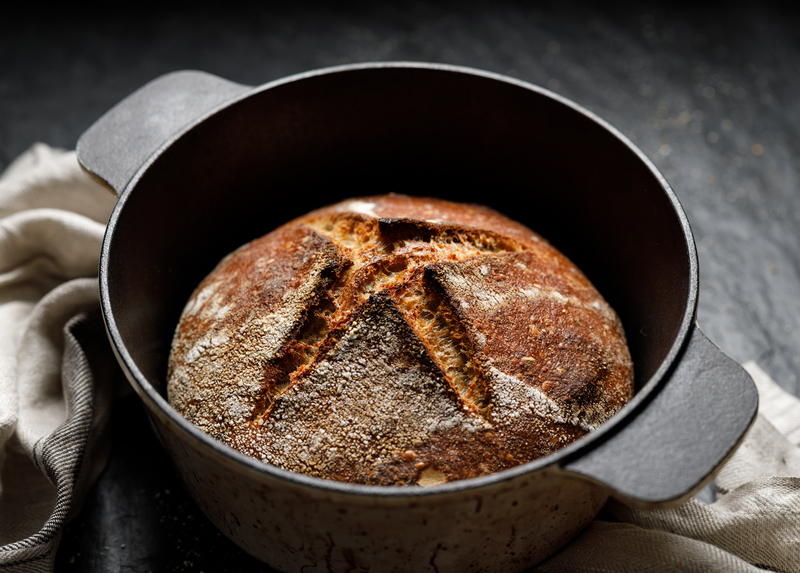 When it comes to baking sourdough bread, there are various techniques and tools that bakers swear by.
When it comes to baking sourdough bread, there are various techniques and tools that bakers swear by.
One such tool that has gained immense popularity in recent years is the Dutch oven.
Baking sourdough bread in a Dutch oven has become a preferred method for many, claiming it produces superior results.
But is sourdough bread truly better when baked in a Dutch oven?
In this article, we will explore the advantages of using a Dutch oven for sourdough bread baking.
The Magic of Sourdough Bread
Sourdough bread is a cherished staple in many households, known for its unique flavor, chewy crust, and soft, airy crumb.
What sets sourdough apart from regular bread is its fermentation process, which relies on naturally occurring wild yeast and lactic acid bacteria.
This process not only imparts a distinct tangy flavor but also enhances the bread’s digestibility and nutritional value.
The Role of a Dutch Oven in Sourdough Baking
 A Dutch oven is a heavy, lidded cooking pot made from materials like cast iron or enamel-coated cast iron.
A Dutch oven is a heavy, lidded cooking pot made from materials like cast iron or enamel-coated cast iron.
It’s renowned for its ability to distribute heat evenly and retain it, creating an ideal environment for baking bread.
Here’s why a Dutch oven is considered advantageous for sourdough bread baking:
- Steam Generation
One of the key factors in achieving a perfect sourdough bread crust is the presence of steam during the initial baking stage.
Steam helps the dough rise and expand rapidly, giving it that coveted oven spring.
Dutch ovens, with their tight-fitting lids, trap steam released from the bread as it bakes, creating a steamy microenvironment.
This results in a thicker, crunchier crust with a delightful sheen.
- Temperature Control
Maintaining a consistent and high baking temperature is crucial for the proper development of sourdough bread.
Dutch ovens excel in this regard because they can withstand high temperatures without losing heat.
The pot’s walls radiate heat evenly, ensuring that the bread bakes uniformly.
This controlled environment helps the bread achieve a beautifully caramelized crust and an open, airy crumb.
Artisanal Aesthetics
Sourdough enthusiasts often strive for artisanal aesthetics in their loaves.
Baking in a Dutch oven allows the bread to expand upward rather than spreading outward.
This containment results in a taller loaf with a more pronounced dome shape, perfect for showcasing those Instagram-worthy slashes and patterns on top.
- Crust Development
The Dutch oven’s ability to seal in moisture during the early stages of baking helps create an ideal environment for crust formation.
As the bread bakes, the moist environment prevents the crust from hardening too soon, allowing it to reach its full potential – a crispy, crackling exterior that contrasts beautifully with the soft crumb inside.
Tips for Baking Sourdough in a Dutch Oven
 Now that we understand why a Dutch oven is favored for sourdough baking, here are some tips to make the most of this method:
Now that we understand why a Dutch oven is favored for sourdough baking, here are some tips to make the most of this method:
- Preheat the Dutch Oven
Always preheat your Dutch oven along with your oven.
This ensures that the pot is at the desired temperature when you place the dough inside, promoting a better rise and crust formation.
- Use Parchment Paper
To prevent the dough from sticking to the Dutch oven, place a sheet of parchment paper in the pot before adding the dough.
This makes it easier to transfer the dough and ensures a uniform bake.
- Experiment with Temperatures
Adjusting the oven temperature during the baking process can yield different results.
Starting with a high temperature (e.g., 450°F or 232°C) and then reducing it after the initial bake helps achieve a dark, crispy crust while maintaining a tender crumb.
- Master the Steam
Besides the steam generated from the dough itself, you can enhance the steam by placing a tray of hot water in the bottom of your oven or using ice cubes inside the Dutch oven just before covering it with the lid.
Lodge Cast Iron Dutch Oven – An Economical Option
The 5 Quart Seasoned Cast Iron Dutch Oven from Lodge is not just a classic cooker; it’s an essential tool for baking bread that consistently delivers exceptional results.
Pre-seasoned and ready to use, this Dutch oven is a kitchen staple.
What sets it apart is its commitment to quality and tradition. Lodge seasons its cookware with 100% vegetable oil, avoiding synthetic coatings or chemicals.
This dedication to natural seasoning means that the more you use it for baking bread, the better it becomes at creating the perfect crust and crumb.
Made in the USA for over 120 years, Lodge’s cast iron is renowned for its high-quality design, lifelong durability, and cooking versatility, making it ideal for bread-making.
With a Lodge Dutch oven, you’re not just investing in cookware; you’re creating lasting memories, as Lodge believes that cooking is about more than just food.
As a family-owned company since its founding in 1896, Lodge’s commitment extends beyond the kitchen, emphasizing environmental responsibility and community development, embodying the heart and soul of American craftsmanship.
Bottom Line – Is Sourdough Bread Better in a Dutch Oven?
 While it’s possible to bake delicious sourdough bread using various methods and tools, a Dutch oven unquestionably offers several advantages.
While it’s possible to bake delicious sourdough bread using various methods and tools, a Dutch oven unquestionably offers several advantages.
Its ability to create a steamy, controlled environment and facilitate crust development makes it a favorite among sourdough enthusiasts.
So, if you’re looking to take your sourdough baking to the next level, consider investing in a quality Dutch oven and explore the wonderful world of artisanal bread baking.
Your taste buds and dinner guests will thank you!



